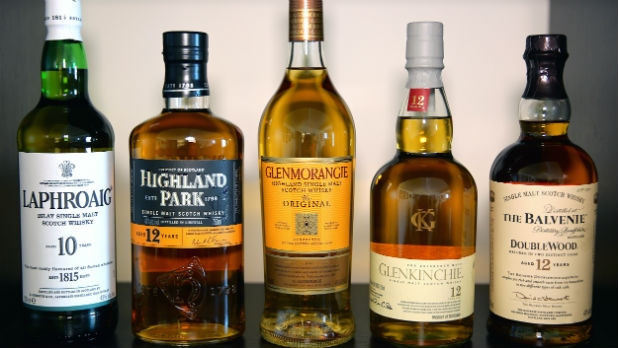How much would you pay for the world’s classiest beverage?
“To Friar John Cor, by order of the King, to make Aqua Vitae, VIII bolls of malt.”
That’s from the Exchequer Rolls in 1494, the first mention of Scotch production. That was enough malt to make about 1500 bottles for Scotland’s royal household. It’s warm and calming sensation gave Scotch a medicinal aura, and so it was used to treat all kinds of ailments. Some still believe that today, but nobody believes you drink it only for a cure.
Scotch is regarded as one of the classiest beverages you can buy and its production is a complicated business. All for good reason, as good scotch can command some healthy prices. Before we get into that, we should go through some facts. Aficionados certainly know all this stuff, but for the rest of us:
-
Scotch can be made from malt or grain, or combinations of the two, but it can only be made in Scotland and as specified by law. So even if you exactly duplicate the process somewhere else, say, Japan, it is not scotch.
-
Scotch falls under the broad classification of whiskey (or whisky, if you prefer that spelling), so all scotches are whiskey, but not all whiskeys are scotch.
-
Scotch has no added substances other than water and caramel coloring.
-
Scotch must be aged in oak barrels no less than 3 years.
“They say some of my stars drink whiskey, but I have found that ones who drink milkshakes don’t win many ball games.”
–Casey Stengel
Here are some general guidelines as to the proper way to drink Scotch:
-
While there’s nothing wrong with using a standard glass, experts recommend a tulip-shaped glass because you can swirl the whiskey and the aromas will concentrate around the neck.
-
Believe it or not, there’s nothing wrong with adding water. Many experienced drinkers do it to reduce the initial burn so you can taste the individual flavors.
-
Ice, on the other hand, is a no-no, but not because of watering down. Lowering the temperature dulls the flavors and aroma. By the way, don’t add cold water if you decide to add some.
Originally, all scotch was made from malted barley. Later on, wheat and rye were introduced, leading to five distinct categories — single malt, single grain, blended malt, blended grain and blended scotch.
So, a single malt Scotch is one that is entirely produced from malted barley in one distillery and a “blended malt” like Johnnie Walker Green, uses only malt but more than one distillery. Single grain means that it was produced by a single distillery but from more than one grain, and blended grain means more than one grain and more than one distillery. Blended Scotch accounts for roughly 90% of Scotland’s production, and includes such well-known brands as Ballantine’s, Chivas Regal, Cutty Sark, Dewar’s, J&B, and Johnnie Walker.
The rest of the way we’ll focus on single malt Scotches — they have a more pronounced flavor and bouquet, and so are the classiest segment of the classiest beverage. Within this segment, the individual brands can taste very different. In large part, it’s because of the water. But it’s also due to the quality of the barrel, the climate of the region, and the peat that’s used in kilns to dry the barley and create malt.
“Always carry a flagon of whiskey in case of snakebite and furthermore always carry a small snake.”
–W. C. Fields
And, of course, aging. Age on a bottle reflects the age of the youngest Scotch in the product. If the age isn’t stated on the label, then it’s 3 years old. Note that aging stops once the Scotch is bottled. So if you think that a 12 year old Scotch you bought in 2000 is 29 years old, it’s not.
The longer the Scotch is kept in the barrel, the better the quality. Aging in oak barrels is important because the characteristics of the wood give the whiskey its distinct taste. With more time, these characteristics continue to be passed on and mellow the flavor.
However, there’s a point where Scotch can be aged too long and won’t taste as good. That’s when the wood overpowers the whiskey, and that’s somewhere between 20 and 40 years. Something to keep in mind when you’re trying to decide whether or not to drop a few hundred or thousand bucks on a 50 year old bottle.
Now, on to price. You’d be amazed at what some people have shelled out for a single malt Scotch. Let’s begin with the absolutely most expensive bottles — notice that many of these are aged 50 years or more. So you can’t even be sure that you’ll enjoy them. But then again, at these prices, who would drink them?
Note that our list only includes single malts from Scotland — there was a bottle from Japan (Yamazaki 50 Year Old) that sold for $133,999, but it’s not a single malt Scotch because it wasn’t made in Scotland.
Macallan M — $628,000
The most expensive Scotch ever was sold at a 2014 Sotheby’s auction in Hong Kong. Just the bottle alone took over 50 hours to make and required 17 artisans. To make the Scotch, seven out of about 200,000 barrels were selected, with the age ranging from 25-75 years.
Macallan 1946 in Lalique Decantur — $460,000
This 64 year old scotch was bottled to celebrate the 150th birthday of René Lalique, who founded one of the world’s most respected crystal production houses. The decantur, with the scotch, was auctioned through Sotheby’s in 2010.
Glenfiddich Janet Sheed Roberts Reserve 1955 — $94,000
Named after the oldest person in Scotland, this scotch was sold at a charity auction in New York in March of 2012. There were only 11 ever made and they were all sold in private auctions.
Springbank 50 Year Old 1919 — $78,000
Unlike the three previous Scotches that you can only buy at auctions, this scotch can actually be purchased right now, and on line. It’s in stock and next day delivery is even available outside the UK. But keep in mind that supplies are limited — only 24 bottles were produced.
Macallan 1926 — $75,000
This is the first from the Macallan Fine and Rare line, hand-bottled at the distillery. A bottle sold at auction in 2007 for $54,000, but another sold for $75,000 in 2005. It is purported that this particular Macallan Scotch can age for 50 years because of the quality of the malt, and that claim is not made for any of the others.
Glenfiddich 1937 — $71,000
This scotch was born the year of King George VI’s coronation. There are only about 60 bottles that haven’t been consumed, and all have been sold at auction. The highest price was achieved in 2012.
Dalmore 62 Single Highland Malt Scotch Matheson 1942 — $58,000
This bottle of Scotch was named in honor of the founder of Dalmore, Alexander Matheson. It was reported that it sold at auction to an anonymous buyer, who then drank it with his friends.
We could go on, but how much insanity can one take? But… just in case you’re up to it, here’s a few that are in the second tier, not being able to break through the $50,000 mark…
Balvenie 50 Year Old 1912 — $42,000
Dalmore Selene 58 Year Old 1951 — $35,000
Macallan 50 Year Old 1949 — $32,000
And then you have the lowly White Bowmore 1964, 43 Year Old Single Malt. This came on the market in 2008, and was only able to fetch about $6,000.
Now for some reality, there are a number of scotches that are very highly rated and actually priced reasonably, and by that I mean not cheap but you won’t need a mortgage. As for me, I’m a Glenlivet 12 Years Old fan, and that sells for about $50, so some of these prices are still more than I’m willing to pay for a beverage. But you may have more a discerning taste than I do (in fact, I’m sure you do.)
Here they are, arranged in descending order by price:
Laphroaig 25 Year Old Cask Strength Single Malt–$650
Highland Park 30 Year Old Single Malt–$370
Glenlivet XXV Single Malt–$350
Highland Park 25-Year Single Malt–$239.
Johnnie Walker Blue Label Blended Scotch–$229
Dalmore 18 Year Old Single Malt–$219
Dewar’s Signature Blended Scotch 27–$219
Macallan 18 year old Single Malt–$140
Here’s mud in your eye.







